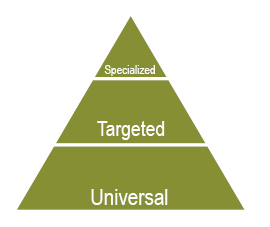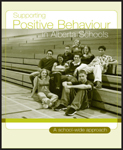
|
Universal Supports benefit all students
- Work collaboratively with school staff to ensure that there are school-wide expectations for lunchtime behaviour and that all school staff are committed to using common prompting with students regarding such practices as seating plans, use of quiet voices and/or cleaning-up routines.
- Do an environmental scan of the current physical space where students will be eating lunch. Ensure there is enough physical space for the number of students staying for lunch, and consider access to sinks, microwaves and garbage cans. Consider alternate groupings and/or seating plans that would maximize comfort for students and be manageable for supervisors.
- Develop a school-wide plan to support active supervision during lunchtimes.
- Take time at the beginning of the school year to teach, practise and review routines related to lunchtime behaviour.
- Post visual reminders for
lunch time behaviour in the area where students will be eating
their lunch. When appropriate, collaborate with students
to develop these visual reminders.
- Use descriptive feedback to acknowledge positive lunchtime behaviour demonstrated by individuals, groups of students and/or the class as a whole.
|
|

|
Targeted Supports benefit students with more specific needs
- Pair individual students with positive peers who can serve as role models and provide support over the lunchtime. Rotate these peers at regular intervals throughout the school year.
- Provide proximity by positioning yourself (or lunch time supervisors) nearby individual students who may require support and/or supervision over the
lunchtime.
- Consider assigned seating for individuals or groups of students that require increased structure and supervision. Label seating clearly.
- Consider using plastic placemats to clearly establish personal space boundaries for each student.
- For students who require more structure and reassurance, develop and review social stories about lunchtime routines.
- For students who have difficulty managing the time between when they finish eating and dismissal for outside, work with them to brainstorm a list of calming activities they can do at the lunch table, such as listening to music on earphones, working on puzzles or playing with small toys.
- Work with individual students to develop low-key cues and prompts that lunchroom supervisors can use as friendly reminders to follow lunchtime rules.
- For students with chronic difficulties at lunchtime, develop self-monitoring
strategies that students can use to reflect on and keep
track of their own behaviour during the lunchtime. It may also be motivating
to set up a systematic approach to reinforcement for
students who are working on improving and maintaining positive behaviour
over the lunchtime. Reinforcement should encourage moving toward intrinsic
motivation (e.g., "How does it feel when you …?").
|
|

|
Specialized Supports benefit the small number of students with sensory, physical, cognitive or behavioural needs that require intensive, individualized interventions
- In exceptional cases, an individual student may need 1:1 adult support for eating. This adult support should be provided as unobtrusively and naturally as possible. In addition, the adult providing this 1:1 support should collaborate with the student's learning team to identify and facilitate as many ways as possible to create opportunities, provide strategies, modify tasks and adjust and/or fade support so that the student can experience some degree of independence at lunchtime.
|






